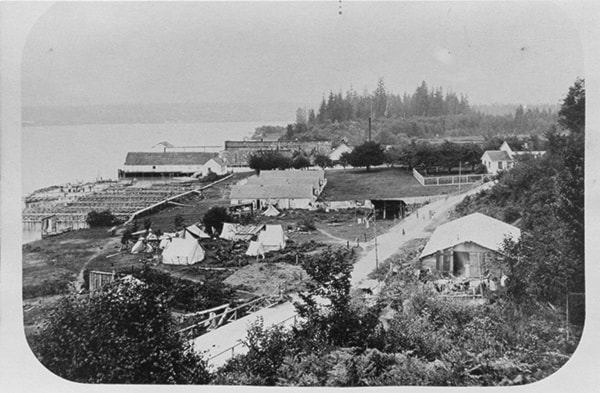EDITOR'S NOTE: The print edition of this story refers to the stop of interest sign in Annieville as missing. This is because it is listed as missing on the government's stop of interest sign inventory.
This morning (Jan. 13), reader John Macdonald contacted the Reporter to let us know that the stop of interest sign in Annieville is, in fact, still there.

"I was surprised to hear that the Annieville stop of interest sign had gone missing. I went out this morning to check on it and found it is still where it always has been on Gunderson Road, just west of Alaska Way," Macdonald wrote.
Macdonald went so far as to send us this photo of the sign he took this morning. Thanks John for letting us know the sign is still safe and sound and where it ought to be. The story below has been updated to reflect this new information.
(Updated story below)
They’re a staple of road trips and vacations for many British Columbians, dotting the landscape from Victoria to the Yukon border, and Deltans have until the end of the month to submit their suggestions for new roadside “stop of interest” signs.
The province unveiled its plan to rejuvenate its existing signs back in September, and will add up to 75 additional stops of interest in late spring/early summer 2017.
“Our province is rich with history and these heritage signs show our commitment to preserving the culture from the past, celebrating the communities of today and inspiring pride for the future in British Columbians,” said Transportation and Infrastructure Minister Todd Stone in a release to media.
B.C.’s stop of interest signs were first planted in 1958 to commemorate the Colony of B.C.’s centenary and to recognize significant historical places, people and events. An inventory of the existing signs was taken in fall 2015, and of the 139 signs that were catalogued, with 75 per cent required repairs, reinstallation and, in some cases, replacement because the content and language is out of date.

Delta is listed as having just one stop of interest sign (pictured) commemorating the thriving salmon canning industry that helped create and grow Annieville. Despite being listed as missing on the stop of interest sign inventory, it is in fact located on Gunderson Road, just west of Alaska Way.
It reads, “This site, on the world’s greatest salmon river, lured many pioneer canners in the late 1860’s and early 1870’s. Pre-eminent was Alexander Ewen, a founder and first president of B.C. Packers, who established a cannery here in 1871. The new salmon canning industry thrived on exports to foreign markets until by 1900 it was among the most important in the province.”
North Delta’s early role in the province’s salmon fishery is a legacy that Delta Mayor Lois Jackson said is too often forgotten.
“Everybody keeps saying ‘Steveston was the first and Prince George was the first in terms of the olden days when they had fish canneries established along the coast,’ but Annieville was a very old area. I think it was the manager of the cannery whose wife’s name was Annie, and that’s how Annieville got its name, actually.”
Many streets and landmarks still bear the names of some of the prominent Norwegian families that settled the area, such as Stegavik Court, Norum Creek and Gunderson Slough.
Trinity Lutheran Church was was dedicated May 22, 1910 and served the fishermen and their families in New Westminster, Brownsville, Annieville and Sunbury. The original building (plus a few more modern additions) still stands on River Road and hosts regular services and community events.

The congregation gathers in front ofTrinity Lutheran Church on No- rum Road for its dedication circa 1905. The church was later moved to its current location on River Road. Photo courtesy of the Corporation of Delta Archives and the Delta Museum and Archives Society.
Of course, European settlers were not the first people to live in the area. Aboriginal people had lived and fished there along the banks of the Fraser River for centuries, as a kilometre-long archeological site between the former St. Mungo and Glenrose cannery sites shows more than 5,000 years of activity.
Though a significant portion of the site is was covered by construction of the South Fraser Perimeter Road, a small park and interpretive walk marks the midden at the southern footing of the Alex Fraser Bridge, near River Road and Centre Street.
The government will be accepting public submissions for new stops of interest until Jan. 31. As of Jan. 2, the government had received 192 submissions.
Suggestions will be reviewed by senior ministry staff from across government, and final selections will also be reviewed by cultural and historical experts for accuracy. Selection will be based on criteria including the impact the person, place or event has had on the lives of British Columbians and the regional distribution of signs. Persons nominated for a sign must be deceased for more than 30 years.
To suggest a stop of interest sign visit engage.gov.bc.ca/stopsofinterest.
With files form Ethan Reyes.
